NIST Strategies: Empowering Small Businesses Against 2025 Cyber Threats
Did you know that advanced cyber attacks now target small businesses just as frequently as large enterprises? Learn how adopting a cloud risk assessment aligned with NIST standards can help you reduce costs, ensure compliance, and stay ahead of emerging threats this year. To protect small businesses in the United States in 2025, implementing a NIST-aligned cloud risk assessment and utilizing the latest cyber security solutions can be a highly effective approach.
Did you know that advanced cyber attacks now target small businesses just as frequently as large enterprises? Learn how adopting a cloud risk assessment aligned with NIST standards can help you reduce costs, ensure compliance, and stay ahead of emerging threats this year. To protect small businesses in the United States in 2025, implementing a NIST-aligned cloud risk assessment and utilizing the latest cyber security solutions can be a highly effective approach.

The National Institute of Standards and Technology (NIST) offers flexible frameworks tailored to manage emerging risks within cloud environments and to counteract advanced cyber threats like ransomware, AI-driven attacks, and vulnerabilities within the supply chain. This comprehensive guide presents an overview of the NIST-based cloud risk assessment process, strategies for risk mitigation planning, and effective implementation of crucial endpoint and cybersecurity solutions.
Delving into NIST Cloud Risk Assessment for Small Businesses
NIST's methodology for cloud security is rooted in a structured, risk-oriented process that is appropriate for varying business scales, even those operating with limited security resources. At the core is NIST SP 800-53, which can be applied to the cloud through a series of six critical steps:
1. Classify Systems and Data Sensitivity: Start by identifying and categorizing the data types and systems you manage in the cloud, whether they're personal, financial, or health-related.
2. Select Applicable Security Controls: Utilize NIST SP 800-53 to ascertain the baseline controls that align with your business's risk profile.
3. Implement Controls: Install and deploy the selected controls within your cloud infrastructure, ensuring integration with your cloud service provider's security capabilities.
4. Assess Effectiveness: Perform evaluations and tests on the deployed controls to ensure they function as intended.
5. Authorize for Use: Secure necessary internal endorsements (plus regulatory approvals, if necessary) based on the risk assessment and control evaluations.
6. Continuous Monitoring: Sustain ongoing vigilance against new threats, configuration adjustments, and system vulnerabilities.
This model effectively channels security investments towards the most significant risks, thus aiding small businesses in streamlining their cybersecurity strategies.
Innovations in the NIST Cybersecurity Framework (CSF 2.0)
Following the release of NIST CSF 2.0 in February 2024, the framework introduced a sixth function: Governance. This inclusion underscores the critical role of leadership oversight, the definition of clear responsibilities, and the synchronization of security practices with business objectives. For small businesses, this can mean:
• Assigning explicit cybersecurity duties to staff members.
• Integrating security decision-making into standard business planning.
• Revising policies in response to changes in business operations or threat landscapes.
Together with the existing elements—Identify, Protect, Detect, Respond, and Recover—paired with the new Governance feature, CSF 2.0 lays down a robust foundation for constant improvement and supports adherence to norms set by HIPAA, PCI DSS, and GDPR.
Crucial Cybersecurity Threats for Small Businesses in 2025
Small businesses remain in the crosshairs of cybercriminals who employ sophisticated techniques, frequently driven by AI and automation. Predominant threats include:
1. AI-Powered Phishing and Malware: These attacks exploit automation to bypass usual detection systems.
2. Ransomware and Double-Extortion: Cybercriminals employ complex, multi-step tactics to apply pressure on victims for financial gains.
3. Deepfake Impersonation: Deceptive audio or video media may be used to facilitate social engineering efforts.
4. Supply Chain Attacks: Security breaches in vendor systems can create unauthorized access routes.
5. Regulatory Fines: Failure to comply with security standards can lead to financial penalties.
Carrying out a NIST-guided risk evaluation assists in prioritizing mitigation efforts according to documented risks.
Defining Roles and Responsibilities in Cloud Security
Cloud security typically involves a shared responsibility between your business and the cloud service provider. Per NIST guidelines, it is vital to document these roles clearly and explicitly:
• Cloud Provider Responsibilities: These usually encompass physical security measures, fundamental infrastructure, and certain platform controls.
• Customer Responsibilities (Your Business): This generally includes data classification, managing access, endpoint security, compliance settings, and monitoring user actions.
Assume nothing about full coverage by the provider; instead, meticulously examine agreements and documentation to clarify role and responsibility allocation.
Enhancing Endpoint Security and Implementing Cybersecurity Solutions
For the year 2025, a multi-layered approach to security is advised:
1. Endpoint Detection & Response (EDR): These solutions apply sophisticated analysis techniques to detect and quarantine threats on individual devices.
2. Zero Trust Principles: Access is restricted and verified, even within an organization’s internal network.
3. Multi-Factor Authentication (MFA) and Identity Controls: Additional verification methods help safeguard against theft or misuse of credentials.
4. Vulnerability and Risk Assessments: Carry out routine evaluations and scans for both endpoint and cloud systems.
5. Employee Security Training: Regular, focused training, encompassing simulated phishing and social engineering tests.
Select solutions that operate seamlessly with your existing IT infrastructure and prioritize regular updates and maintenance.
Leveraging Managed Cybersecurity Services
Managed Security Service Providers (MSSPs) can significantly assist small businesses in addressing their security needs. Such services may include:
• Access to Advanced Defense Capabilities: MSSPs often provide intrusion detection, continuous monitoring, incident response, compliance support, and regular evaluations.
• Cost flexibility: These services allow small businesses access to specialized skills and resources without needing to hire additional in-house staff.
• Compliance Assistance: MSSPs frequently help align NIST controls with regulatory requirements and reporting duties.
Managing Supply Chain and Vendor Risks
Mitigating supply chain risk is an essential element of a comprehensive cybersecurity strategy, involving steps like:
• Establishing clear security requirements and expectations for vendors.
• Requesting or conducting audits of vendor cybersecurity practices, including controls over access and credentials.
• Applying the "least privilege" principle to limit the data access granted to vendors.
• Continuously monitoring and reviewing third-party actions.
NIST offers guidance and checklists to aid in managing cybersecurity within the supply chain.
Sustaining Ongoing Security Enhancements
NIST frameworks prioritize continuous improvement by:
1. Updating Risk Assessments: Re-evaluate risks regularly as new threats and technologies appear, and as regulations evolve.
2. Reviewing and Refining Policies: Revise procedures as required, particularly in response to security incidents or third-party audits.
3. Regular Staff Training: Consistent employee training equips them to spot emerging attack techniques and vulnerabilities.
4. Maintaining Documentation: Detailed, up-to-date records are vital for regulatory compliance, insurance, and reaction to incidents.
Budgeting and Practical Implementation
While tool pricing varies, utilizing NIST guidance can help optimize the allocation of resources by focusing on high-priority risks. Most major cloud platforms provide controls that align seamlessly with NIST frameworks, whereas supplemental tools (such as EDR solutions, MSSPs, and professional audits) typically involve recurring subscription fees based on specific needs and scale. For very small businesses, emphasizing security awareness training and reviewing fundamental cloud configurations offers a pragmatic and effective starting point.
Conclusion
In 2025, it's recommended that U.S. small businesses adopt a proactive stance on cybersecurity. By implementing NIST-based cloud risk assessments, alongside cutting-edge endpoint security practices, compliance alignment, employee education, and persistent improvements, businesses can craft a comprehensive and sustainable cybersecurity program. Embracing established frameworks and leveraging managed services will help them confront present-day cyber threats while sustaining growth and operational momentum.








